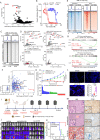This is a preprint.
Targeting the mSWI/SNF Complex in POU2F-POU2AF Transcription Factor-Driven Malignancies
- PMID: 38328238
- PMCID: PMC10849552
- DOI: 10.1101/2024.01.22.576669
Targeting the mSWI/SNF Complex in POU2F-POU2AF Transcription Factor-Driven Malignancies
Update in
-
Targeting the mSWI/SNF complex in POU2F-POU2AF transcription factor-driven malignancies.Cancer Cell. 2024 Aug 12;42(8):1336-1351.e9. doi: 10.1016/j.ccell.2024.06.006. Epub 2024 Jul 18. Cancer Cell. 2024. PMID: 39029462 Free PMC article.
Abstract
The POU2F3-POU2AF2/3 (OCA-T1/2) transcription factor complex is the master regulator of the tuft cell lineage and tuft cell-like small cell lung cancer (SCLC). Here, we found that the POU2F3 molecular subtype of SCLC (SCLC-P) exhibits an exquisite dependence on the activity of the mammalian switch/sucrose non-fermentable (mSWI/SNF) chromatin remodeling complex. SCLC-P cell lines were sensitive to nanomolar levels of a mSWI/SNF ATPase proteolysis targeting chimera (PROTAC) degrader when compared to other molecular subtypes of SCLC. POU2F3 and its cofactors were found to interact with components of the mSWI/SNF complex. The POU2F3 transcription factor complex was evicted from chromatin upon mSWI/SNF ATPase degradation, leading to attenuation of downstream oncogenic signaling in SCLC-P cells. A novel, orally bioavailable mSWI/SNF ATPase PROTAC degrader, AU-24118, demonstrated preferential efficacy in the SCLC-P relative to the SCLC-A subtype and significantly decreased tumor growth in preclinical models. AU-24118 did not alter normal tuft cell numbers in lung or colon, nor did it exhibit toxicity in mice. B cell malignancies which displayed a dependency on the POU2F1/2 cofactor, POU2AF1 (OCA-B), were also remarkably sensitive to mSWI/SNF ATPase degradation. Mechanistically, mSWI/SNF ATPase degrader treatment in multiple myeloma cells compacted chromatin, dislodged POU2AF1 and IRF4, and decreased IRF4 signaling. In a POU2AF1-dependent, disseminated murine model of multiple myeloma, AU-24118 enhanced survival compared to pomalidomide, an approved treatment for multiple myeloma. Taken together, our studies suggest that POU2F-POU2AF-driven malignancies have an intrinsic dependence on the mSWI/SNF complex, representing a therapeutic vulnerability.
Keywords: IRF4; POU2AF1/2/3; POU2F3; SMARCA2/4; mSWI/SNF complex; multiple myeloma; proteolysis targeting chimera (PROTAC); small cell lung cancer (SCLC).
Figures





References
-
- Nicholson A.G., Chansky K., Crowley J., Beyruti R., Kubota K., Turrisi A., Eberhardt W.E., van Meerbeeck J., Rami-Porta R., Staging, et al. (2016). The International Association for the Study of Lung Cancer Lung Cancer Staging Project: Proposals for the Revision of the Clinical and Pathologic Staging of Small Cell Lung Cancer in the Forthcoming Eighth Edition of the TNM Classification for Lung Cancer. J Thorac Oncol 11, 300–311. 10.1016/j.jtho.2015.10.008. - DOI - PubMed
Publication types
Grants and funding
LinkOut - more resources
Full Text Sources
Molecular Biology Databases
Research Materials
